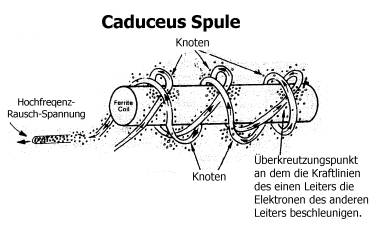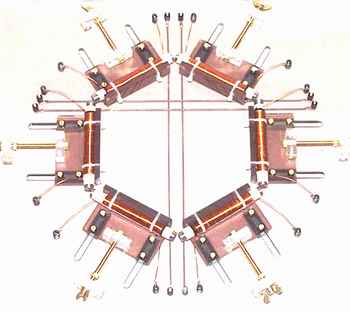Time Travel Research Center © 2005 Cetin BAL - GSM:+90 05366063183 - Turkey/Denizli
Turkish Electromagnetic Propulsion Technologhy
Çetin BAL: Antiyerçekimi ( Antigravitation ) araştırmacıları yada elektromanyetik alan sevki üstünde çalışan arkadaşlara şunu önemle ifade etmek isterimki eski Nazi Almanyası'nda sözde örnekleri olan ve bu konuda ilk deneysel araştırmalara girmiş Nazi bilim adamlarının çalışma kayıtlarından ele geçen ifadelere göre zaman ve boyutlar arasında yerdeğiştirebilecek sözde araçlara dair taktim edilen elektronik ve teknik bilginin ve bulguların ne derecede gerçekçi olduğu şüphe vericidir. Ele geçen bulgulara göre Tachionators denen özel bobin sarılı devre düzenekleri ile bir takım güç alanları üretildiği ve bu alanların yardımı ile Vril, Haunebu, Odin, RFZ denen hava ve uzay taşıtlarının hareket ettirilebildiğine dair bir çok bilgi verilmektedir. Tabi bu beyanda hemen karşımıza yüksek frekans bobinleri, Tesla bobinleri ( Tesla Coil) ve elektromanyetik vorteks( girdap) alanları üreten çok değişik bobin düzenekleri-bobin sarımları ortaya çıkmaktadır. Diğer yandan yüksek yoğunluklu iyon rügarlarını içeren döner alanlar, yüksek yoğunluklu elektrostatik alanlar yada elektromanyetik alanla karışmış elektrostatik alanlar karşımıza çıkmaktadır.UFO denen bu sözde araçlarda kullanılan bu yerçekimi karşıtı güç (bu alansan enerji) nasıl bir enerjiyi ihtiva etmektedirki cisim yerden havada öylece asılı durabilmekte ve istediği yöne hareket edebilmektedir? Şimdi derin mühendislik düzeyinde düşündüğümüzde uzay ve zamanda yol alabilen boyutlar arasında yerdeğiştirebilen bir makinenin kesinlikle elektriksel ve elektromanyetik alan güçleri dahilinde iş görmesi ve uzay/zaman dokumasını bir şekilde lastik gibi eğip bükerek kendisini yerçekimsel bir dalga atması boyunca hareket ettirebilmesi gereklidir.Tüm bu UFO hikayelerinin ardındaki temel Propulsion (sevk gücü) mantığı bu fikre dayanır. Lakin bu gerçeği pek az ''UFO teknolojisi'' araştırmacısı keşfedebilmiştir.Çok çapraşık ve belirsiz bilgi kaynakları dahilinde bir çok kavram havada uçuşsada bunları doğru şekilde bir araya getirecek ve bu bilgi karmaşası içinden anlamlı bir takım bulgulara varacak olanda yine bizleriz. Bir yanda gizemlerle dolu Philadelphia Deneyi ( Philadelphia Experiment ) bir yanda 51. bölge (hava üssü) dahilinde Bob Lazar'ın Uçan daireler hakkında verdiği bilgiler bir yanda Nazi uçan daire teknolojileri ve diğer yandan da gerek akademik tabanlı gerekse bir takım bağımsız araştırmacılardan gelen bir çok kuramsal ve teknik uygulamaya dayanan sevk yöntemlerinin söz konusu olduğu bir ortamda doğru parçaları bir araya getirerek ışıktan hızlı sevk teknolojisine dair gerçek ve uygulanabilir bir sistemin nasıl olacağına dair bir ön görüde bulunmak oldukça zor! Ben Türkiye'de bu araştırmaları sürdüren biri olarak ekonomik anlamda, laboratuvar anlamında imkanlar bulmakta zorlansamda en azından bu bilimsel araştırmalarımı kuramsal anlamda sürdürmeye devam ediyorum. Sonuçta bu konulara dair birilerinin kabul edegeldiği sevk teknolojileri mantığını benimsemekten çok bu konu üstünde çalışan Türkiyedeki arkadaşlara konuya dair kendi özgün fikirlerini ortaya koymalarını ve yeni düşünceler, yöntemler üstünde durmalarını tercih ederim. Sonuçta biliyoruzki bir şekilde elektromanyetiksel yada elektriksel bir alan gücü ile hava araçlarımızı sevk edebiliriz. Fakat bunun nasıl olacağı bilgisi laboratuvara girip deneysel düzenekler üstünde test yapılmadığı sürece hep bir muammadan(bilinmezden) öteye geçmeyecektir.


Temelde basit bir UFO ( Elektromanyetik Sevk Aracı) modeli elektrostatik ve elektromanyetik güç alanlarının uygun bir şekilde bir araya getirilmelerine dayanan bir teknik sistemi öngörmektedir. Bir girdap şeklinde dönen iyon alanları uçan diskimizi uzayın vakum boşluğu içerinde ileri doğru iterek hareket ettirmektedir. Bir bobinden çıkan yüksek güçte manyetik girdap alanlarına eşlik eden yüksek elektrik potansiyeli altında ( yüksek voltaj jeneratörleri / Tesla Coil ) serbest kalan elektronlar uçan diskimizi yerçekiminden yukarı doğru iterek bir çeşit elektrostatik bir itme alanı denebilecek antigravitasyonel bir etki alanı oluşturmuş olur. Biz Denizli'de bir laboratuvarda gizli dosyalara eklediğimiz böyle bir uçan disk deneyini başarıyla denedik. Sisteme ait tüm montajı tamamladığımızda ancak karanlıkta görülebilecek pembemsi ve mavi bir yüksek gerilim ışıması 15 santimlik diskimizin çevresini sararak diski gözlerimizin önünde havaya yükseltti fakat disk bir süre yükseldikten sonra görünmeyen iyon girdabı üstünde havada öylece asılı kaldı. Sanki disk rüzgarda bulunduğu yerde dengede durmaya çalışan salınan bir yaprağa benziyordu. Yüksek gerilim voltajını ve bobin alanlarını arttırdığımızda disk bir yayın üstünden zıplayıp seken top gibi yada gerilmiş yaydan fırlayan bir ok gibi hızlıca fırlayarak laboratuvarın tavavına çarptı! Burdaki teknik bilgiyi olduğu gibi vermek sakıncalı olduğundan sadece uçan diskimizin çalışmasına ait temel mantığın anlaşılması yeterlidir. Burda diskin yukarı doğru hareket etmesine neden olan şey kendi kuramsal düşünceme göre yüksek voltaj alanlarınca üretilen, diskin alt tarafındaki ''statik gerilim basıncının ( iyon alanları baskısının)'' üstündekinden daha yoğun olduğu bir durumdan kaynaklanmaktadır. [ Ben bu keşfettiğim yeni etki alanına ''Çetin BAL Etkisi'' ( cetinbal effect) ismini veriyorum.]
... Böylece alüminyum diskimiz alttan yukarı doğru alüminyum levhaya uygulanan geri beslemeli bir elektriksel alan baskısı sayesinde kendi ürettiği alanlar üstünde yükselme olanağı elde etmektedir. Alüminyum diskimiz bir açıdan yüksek voltaj plakası olarak işlev görmektedir. Deneyde kullanılan merkezi elektromıknatısın ''manyetik alanı'' diskten yayılan elektriksel dalgaları diskin altına doğu sürerek bir tür elektriksel alan basıncı etkisi yaratır. Sonuç olarak disk, manyetik girdap alanlarınca yönlendirilen elektriksel bir plazma bulutu üstünde yükselir.
Electrostatic Field + Electromagnetic Field = Elektrogravitic Field -- ( Antigravity Disc )
Çetin BAL Etkisi ( Cetinbal Effect ) : UFO propulsion
Fakat tüm bu deneylere rağmen bizim asıl amacımız zaman boyutları arasında atlayabilecek özel olarak tasarımlanmış güç alanları üstünde kendini hareket ettirebilecek uçan diskler yapmaktır. Yani hedefimiz Uzay/zaman dokumasına doğrudan etki edebilecek ve ışık hızını aşabilecek hava araçları yapmaktır. Ki böyle bir araca hava aracından çok ''uzay aracı'' demek yada daha ileri safhada ''zaman makinesi'' demek daha doğru olacaktır.Zaman boyutlarını aşacak bir uçan araç söz konusu olduğunda artık yüksek gerilim alanlarından ziyade yüksek frekanslı elektriksel alanların kullanımı gündeme gelmektedir. Eğer yüksek frekanslı gerilim alanları üstünde bir diski ışık hızına yakın hızlarda yada daha alt hız düzeylerinde bile hareket ettirebildikten sonra artık bu diski bir zaman makinesine dönüştürebiliriz. Işık hızını nasıl geçebiliriz? Diski çevreleyen alan frekanslarındaki çok küçük bir ayarlama bir boyut değişikliği ile sonuçlanacaktır bu ise bizi bir çeşit bir tünel etkisi ile ışık hızı duvarını kırmadan ışık hızını geçmemizi sağlayacak yada ışık hızı duvarının üstünden atlamamıza olanak tanıyacaktır.Yani diski yüksek gerilim alanlarından doğan potansiyel farklarını kullanarak ileri doğru hareket ettirirken bu kutuplar arasındaki elektriksel alan gerilimine ait frekansın yükseltimi bizi uzaya bağlı zaman dalgalarımız arasında ileri ve geri olmak üzere kaydırabilecektir. Derin fizik mühendisliği çerçevesinde düşündüğümüzde ''zaman akımı'' dediğimiz şey temelde elektriksel bir titreşim dalgasının kendisini boyutsal bir kalıp olarak ortaya koymasından başka bir şey değildir. Tüm evren aslında elektrik dalgalarının farklı durumlarının insan algısı içinde farklı şekillerde yorumlanmasından başka bir şey değildir. Bir parçacık temelde vorteks halini almış bir elektrik alan kasırgasıdır. Tüm atomik parçacıklar, ışık dalgaları, uzay, zaman ve yerçekimi dediğimiz herşey elektrik dalgalarının değişik yoğunluk hareketlerinden başka bir şey değildir.
Eğer elektromanyetik sevk prensiplerince çalışan uzay aracımızın zaman boyutları arasında atlaması ( Time Travel) düşünülüyorsa oldukça yüksek bir elektriksel alan titreşimleri oluşturacak ''Yüksek Frekanslı Elektriksel Alan Bobinleri'' ne ihtiyacımız olacaktır.Belki bu noktada süper iletken bobin sistemleri ( Superconductive Coil System) kullanılabilir. Radyo vericilerinde kullanılan alan bobinlerinden Mikro dalga ( Micro Wave) verici sistemlerine doğru ilerlerken kullanılan yüksek frekans tekniğide( High Frequency Technic ) değişim göstermektedir.Elektrik enerjisinin kullanım olanakları konusunda uygarlığımız henüz yeni tanışmıştır. Ve her geçen gün elektriğin ve elektromanyetik alanların farklı kullanım biçimleri gündeme gelmektedir. İleri bir teknolojik anlayış safhasında elektriksel alan güçleri zaman ve uzay boyutları arasında bizi ışıktan daha hızlı hareket ettirebilecek yeni sevk yöntemlerinde kullanılacaktır. Elektiriksel alan güçleri ile sevk edilen disk biçimli uzay araçlarının hızı bilinen konvansiyonel hava araçlarının ( roketler, jet uçakları) hızına kıyasla çok daha büyük olacaktır. Bu hız nerdeyse ışık hızı civarlarında bir hız olacaktır.
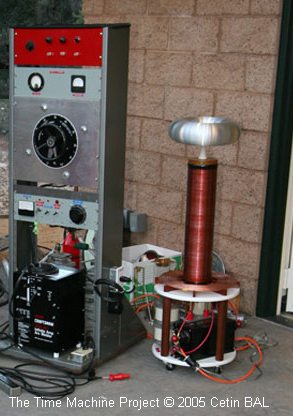

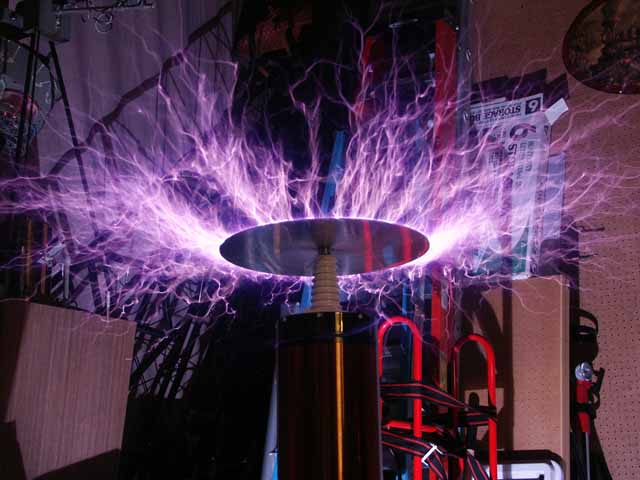
Levitationsmaschinen
Der Raumäther Helion 2 strömt mit unserer maximalen Fallgeschwindigkeit (9,8 M/Sek) von dem Van Allen Gürtel in Richtung Erdplasmakern. Um levitieren zu können muss eine vertikale Teilchenströmung (Helion 2) produziert werden.
Diese muss stärker sein als die natürliche Gravitationströmung.
Es gibt verschiedene Möglichkeiten solche Strömungen zu bilden.
1. Rotation von Teilchen. Diese können aus festen Stoffen, auf fast 0 Kelvin gekühlte Gasen oder aus Teilchen-Plasma.
2. Plasmareaktor der Energie abgibt. Dieser Reaktor produziert eine Teilchenströmung zum Reaktor.
Eine gute Levitationsmaschine muss eine dichte Zelle darstellen. Wenn eine Projektil oder ein Allgestein in die unmittelbare Nähe der Levitationsmaschine gelangt, verliert es den größten Teil seiner Massenträgheit und schlägt leicht gegen die Bordwand. Die Flugscheibe fliegt mit der scharfen Außenkante voran, so das die Gase und Gegenstände an der Rundung vorbei strömen können.
Bild rechts: Die Form der Levitationsmaschine muss eine ideale Form aufweisen, damit das Plasma mit minimalsten Verlusten strömen und umkehren kann.
Wenn eine optimale Form oder dessen Inhalt schnell rotiert, wird dessen Plasmaströmungsgeschwindigkeit und Dichte verstärkt. Das Objekt kann levitieren.
Formen von Oszillatoren und Levitationsmaschinen siehe: Oszillatoren und Projekte.
Levitationsmaschine mit
rotierenden Scheiben

 Im
Sommer des Jahres 1922 wurde an dem ersten untertassenförmigen Flugschiff
gebaut. Sie bestand aus einer Scheibe von acht Metern Durchmesser aus, über
der sich eine parallel gelagerte Scheibe von sechseinhalb Metern Durchmesser
befand, und darunter eine weitere Scheibe von sieben Metern Durchmesser.
Diese drei Scheiben wurden in der Mitte von einem 1.80m messenden Loch
durchbrochen, in dem das 2.40m hohe Antriebsaggregat montiert war. Die
Scheiben sind aus Nylon oder Perlon mit einer dünnen Metallplatte. Unten
lief der Mittelkörper in einer kegelförmigen Spitze aus, von der aus ein in
das Kellergeschoß reichendes Pendel für die Stabilisierung des Geräts sorgte.
Im
Sommer des Jahres 1922 wurde an dem ersten untertassenförmigen Flugschiff
gebaut. Sie bestand aus einer Scheibe von acht Metern Durchmesser aus, über
der sich eine parallel gelagerte Scheibe von sechseinhalb Metern Durchmesser
befand, und darunter eine weitere Scheibe von sieben Metern Durchmesser.
Diese drei Scheiben wurden in der Mitte von einem 1.80m messenden Loch
durchbrochen, in dem das 2.40m hohe Antriebsaggregat montiert war. Die
Scheiben sind aus Nylon oder Perlon mit einer dünnen Metallplatte. Unten
lief der Mittelkörper in einer kegelförmigen Spitze aus, von der aus ein in
das Kellergeschoß reichendes Pendel für die Stabilisierung des Geräts sorgte.
Die Scheiben werden von den
Raumätherfäden (Helion 2), die von dem Van Allengürtel in Richtung
Erdplasmakern strömen durchströmt. Alle Scheiben sind mit der Hohlwelle
verbunden, und drehen mit mittleren Umfangsgeschwindigkeit über 100m/sec in
die selbe Richtung.
Wenn die Scheiben sich bei Draufsicht nach rechts drehen (Helion 1),
induziert nach der Rechten Handregel eine Strömung mit den nächst größeren
Teilchen (Helion 2), von oben nach unten. Wenn die Strömungsdichte der
Maschine höher ist, als die natürliche, saugt sie sich gegen den
herunterströmenden Raumäther nach oben, und levitiert.
Vril
Adolf Hitler ließ 1910 die Vril-Gesellschaft gründen.
Die Fluggeräte wurden in den Donier Flugzeugwerken hergestellt.
Die Erste Flugmaschine wurden von Dr.Gleissner aus einer großen Wilmhust
Influenz-Doppel-Rotor-Maschine gebaut.
Die Rotoren wurden abgerümpft auf ein Auto-Differenzial montiert.
Die Kardanwelle wurde blockiert.
Die untere Scheibe wurden mit einem Vierzylinder BMW Benzinmotor über eine
isolierte Holzwelle angetrieben.
Die Hochspannung wurde eine Ladungszylinderanlage gegeben und mit einem
Kugelblitz-Oszillator gepulst auf zwei doppelsinnig gedrehte Doppel-Differenz-Signal-Amplifier
gegeben.
Die Hochspannung zusammen mit der Funkenentladung wurde an den Seiten
abgeführt auf ein Tunnelblech, wo jedes Ende aus einer Seite der
Tragflächenscheiben-Rotor-Verkleidung schoss.
So konnte das VRIL-Fluggerät nur um 90grad Drehungen und Signalfeuer aus dem
Weg gleiten.
Wegen einer Funkenkorona von der obersten auf die unterste Scheibe, wurde
eine Gleichrichter-Transformtor-Platte zwischen den beiden Scheiben montiert.
Diese Scheibe wurde aus drei verschiedenen Schichten hergestellt.
Bei weiteren Experimenten wenn die Hochspannung wieder über ein
Wechselrichter über einen Resonanz-Amplifier zu den Scheiben der
Wilmhustmaschine geführt wurde, das sich die Scheiben nach den auskuppeln
des Motors sehr intensiv weiter drehten.


Danach wurde die Testatika-Technik in das VRIL-Fluggerät eingebaut.
Die Rotoren wurden mit einer Kondensatorladung gestartet.

Der Monteur mit seinen Anhängern wurde 1974 in Prag bestattet.
In Österreich ist die Intuition der Freien Energie deshalb über das
Morphogenetische Geistesfeld angeregt.
Er ist 1989 in der Lebens- und
Glaubensgemeinschaft Mehernita in Linden bei Bern (Emmental) von Paul
Baumann entwickelt worden.
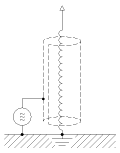 Ein
Modell hat eine Die Scheiben werden von Hand gestartet.
Ein
Modell hat eine Die Scheiben werden von Hand gestartet.
Das Herz sind zwei frei oszillierende symmetrische Magnetspulen
auf den Hufeisenmagnet, die in Resonanz mit je 4 mit Radon beschichten
Kondensatoren stehen. Diese werden durch zwei kapazitive Transformatoren
hochgespannt, und in die Elektrostatikmotor-Influenzmaschinen Kombination
gespeist. www.hcrs.at/kaptrafo.htm
Die Influenzmaschine www.hcrs.at/influenz.htm http://www.coe.ufrj.br/~acmq/electrostatic.html
arbeitet etwas als Zwirl, und generiert stark
energetische Hochspannung, die mit den Teslatransformatoren herunter
transformiert wird. Die symmetrischen Magnetspulen
werden durch den Stromfluss stärker magnetisiert, und die
Magnetflussspiralen werden weiter beschleunigt. Die zwei symmetrischen
Systeme Pendeln voneinander gestützt. Das Gerät generiert 270 -320 Volt
Gleichstrom, und eine Dauerleistung von 3-4kW,
(je nach Luftfeuchtigkeit).

Bild rechts: Influenzmaschine der Thule (Vril) Levitationsmaschine. Die drei
Scheiben drehen sich im Raumäther
Die Influenzmaschine wird mit
zwei Tachionatoren mit Ionen bestrahlt,
und treibt sich selbstständig als Elektrostatischer Motor an
Testatika

Zeitmaschine
An der Rückseite des Stuhles befindet sich
eine Influenzmaschine.
Die Zeitmaschine wurde mit einer Wilmhust-Influenzmaschine dargestellt.
An den Seiten stehen die Transformations- Tachionen- Beschleuniger.
Die Person wird extrem energetisiert und wandert in der Zeit.
H.G.Wells Time Machine Film

RFZ 1
Nach dem Erfolg des kleinen RFZ 2 als Fernaufklärer bekam die Vril-Gesellschaft ein eigenes Versuchsgelände in Brandenburg. Ende 1942 flog die leicht bewaffnete Flugscheibe »VRIL-1-Jäger«. Es war 11,5m im Durchmesser, ein Einsitzer, hatte einen »Schumann-Levitator-Antrieb« und eine »Magnetfeld-Impulsor-Steuerung«. Es erreichte Geschwindigkeiten von 2,900 bis zu 12,000 km/h, konnte bei voller Geschwindigkeit Flugänderungen im rechten Winkel durchführen, ohne daß die Piloten davon beeinträchtigt waren, war wetterunabhängig und hatte eine Weltallfähigkeit von 100%. Von Vril 1 wurden 17 Stück gebaut und es gab auch mehrere zweisitzige, mit einer Glaskuppel ausgestattete Varianten. Das erste Projekt wurde von dem an der TH München tätigen Prof. Dr. Ing. W 0. Schumann geleitet, in dessen Rahmen bis Anfang 1945 17 diskusförmige 11.5 Meter durchmessende Raumflugscheiben gebaut worden sind, die zu insgesamt 84 Testflügen aufgestiegen sind, die sogenannte »VRIL-1-JÄGER«.

Do-Stra S 1
Haunebu 1
Die Rotorscheiben der Influenzmaschine befinden sich in der
halbrunden Kuppel.
Die Influenzmaschine wird mit einer Hochspannungsladung gestartet,
und blieb dann selbständig am laufen.
Vergleichbar mit de Testatika.
In der Haunebu drehten sich nicht die Scheiben, sondern die Abnehmer auf
einem Rotor.
4 Fach-Influenzmaschine
Levitationsfluggerät mit 3-Fach-Influenzmaschine.
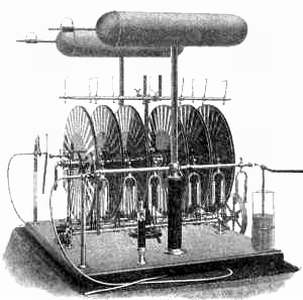
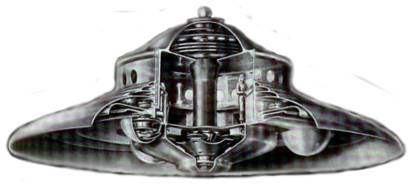
The Wimshurst Machine
Wimshurst machines are the end point of the long development of electrostatic disk machines. They caused very good results and were frequently used to power X-ray tubes. The characteristic construction element of these machines are disks which are laminated with radially arranged metal sheets. The advantage of disks is that they can be stacked onto one axle in order to multiply the effect. The invention of the electomagnetic inductor by Ruhmkorff in 1857 began to make the electrostatic disk machines obsolete. Today, both devices only serve as useful demonstration objects in physics lessons to show how electric charges accumulate. For technical applications, high voltages can be easier generated by electronic and electromagnetic methods.
Haunabu 1
Die Rotorscheiben der Influenzmaschine befinden sich in der
halbrunden Kuppel.
Die Influenzmaschine wird mit einer Hochspannungsladung gestartet,
und blieb dann selbständig durch einen Tachionator am laufen.
Vergleichbar mit de Testatika.
In der Haunebu drehten sich nicht die Scheiben, sondern die Abnehmer auf
einem Rotor.
Levitationsfluggerät mit 3-Fach-Influenzmaschine.
Haunebu 3
Kathoden-Stahlröhre (Catode-Ray-Tube
CRT) arbeitete mit einem Frequenz-Spektrum im UHF-Bereich.
Die Zirkularspulen, Magnetpole und flange sind suggestiv für das
Fluggerät.
Durchmesser = 45 Meter.
Höhe =15 Meter; einstöckige Raumschiffpiloten- und Passagierzelle oben.
Antrieb = Triebwerk Y-7/0,
Horizontaldurchmesser 58 m, mit SM-Levitator E-24 V.,und Y-Schwing-Glocke
verstellbar,
Höhe 140 cm, Breite 50 x 70-90 x 50 cm.
Steuerung = Magnet-Feld-Impulser 4a.
Geschwindigkeit = maximal Fastlichtgeschwindigkeit = ca. 500 000 km/sec., im
normalkosmischen Antigravitations-raumflug; 5 x Lichtgeschwindigkeit = ca.
900 000 km/sec. , = Dreifachüberlichteffekt im überräumlichen
Dimensionskanalflug.
Reichweite = rein theoretisch unbegrenzt
Bewaffnung
4 x Mk-108-Drillingsbatterien
4 drehbareGeschützhalterungen mit je 5 gebündelten Maschinenkanonen Kaliber
5 cm,
Schussfolge 660 Schuss je Mk-108;
2 x Mk-108 Drillingsbatterien an der Raumschiffoberseite,
2 x Mk-108-Drillingsbatterien an der Raumschiffunterseite;
vorübergehende Montage eines KSK -Donar-Strahlgeschützes Kaliber 11 mm im
Experimentalstadium in einem schmalen Panzerturm an der zentralen
Raumschiffunterseite
leicht seitlich versetzt;
Fernsteuerung aller Geschütze an der Raumschiffunterseite.
Außenpanzerung = Doppel-Viktalen-Panzerung 1945/44,
Dreischott-Viktalen-Panzerung 1944/45.
Besatzung = maximal ca. 14 Mann, 2 Mann bei Test Januar 1944.
Weltallfähigkeit = 100%.
Stillschwebefähigkeit = vermutlich ca. 25 Minuten wie bei Haunebu-III.
Allgemeines Flugvermögen = wetterunabhängig Tag und Nacht.
Grundsätzliche Einsatztauglichkeit im Januar 1944 erster Dimensionskanal-Testflug
bei einigen Stunden Bordzeit und einigen Monaten Erd.- und Universumszeit
mit Rückkehr in stark beschädigtem Zustand, da sich die Raumschiffzelle als
zu schwach gebaut erwies, wonach Vril-7 nach einer Generalüberholung mit
Zellenverstärkung und zusätzlichen Verkleidungen bis zur Übergabe an die SS
im April 1945 nur mehr für Geheimtransporte auf der Erde verwendet wurde.
Sowohl konstruktiv als auch antriebsmäßig war das Vril-7 nur eine stark
vergrößerte Version des Vril-1. Ob jedoch auch Vril-1 so wie Vril-7 zu einer
Dimensionskanalreise fähig war, ist unbekannt.
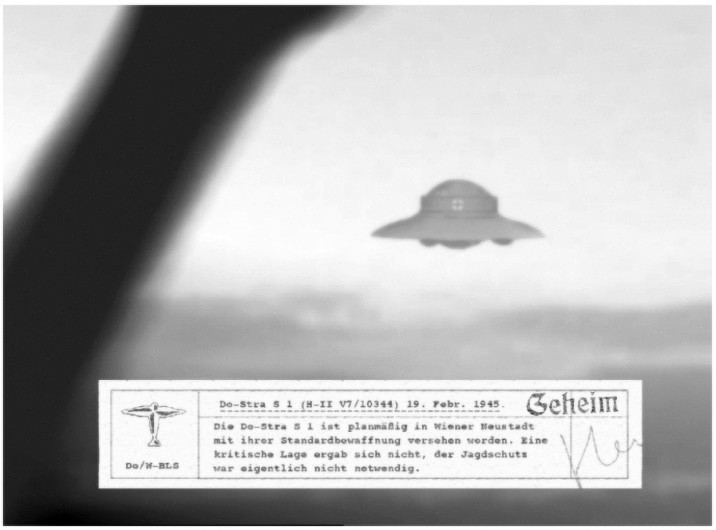
Levitationsmaschine mit Anihilationsreaktor
Annihilation (oder
Paarvernichtung)
Unter Annihilation versteht man den Prozess, bei dem ein Teilchen sein
Antiteilchen trifft und beide verschwinden. Die Energie der Teilchen tritt
dabei in anderer Form auf, z.B. als g-Quanten, als Mesonen oder auch als
anderes Teilchen-Antiteilchen-Paar. Erlaubt sind alle Kombinationen von
Teilchen, die die Erhaltung der Energie und des Impulses erfüllen.
Die bekannteste Annihilation ist die von Elektron und Positron (e+
- e- - Annihilation) in zwei bzw. drei g-Quanten.
Die ersten Anihilationsreaktoren wurden mit einer Influenzmaschine versorgt. Die energetische Hochspannung der Influenzmaschine wird durch eine Penthodenröhre von einer Bodenradaranlage moduliert, damit das Plasma ein rotierendes Magnetfeld induzieren kann. Das rotierende Magnetfeld verstärkt sich selbstständig, und beschleunigt die Teilchenströmung von der Röhrenanode zu der Bleikappe. Der obere Ausgang wird über ein Blendventil vergleichbar mit der Blende einer Kamera geregelt. Dieser Ausgang erzeugt eine Ausgleichströmung, gegen die Amplifikatoren.
Die Amplifikatoren sind Kegelspulen auf einem Eisenkern. Sie werden kapazitiv an den Anihilationsreaktor angekoppelt.

HAUNEBU III
Das HAUNEBU III mit 71 m Durchmesser wurde 1929 in Deutschland nur einmal gebaut und stieg zu mindestens 19 Flügen auf (ca. 7.000 km/h).
Fassungsvermögen ca. 70 Menschen.
Dieser Text wurde gemäß der Aussage eines Ingenieurs Robert Lazar geschrieben, der auf der Ära 51 die Antriebssysteme von außerirdischen UFO´s studierte und ergründete.
In dem UFO ist alles fließend abgerundet, gekurvt nicht zu stören. Das Ufo besteht aus drei Stockwerken. In dem unteren Stockwerk befinden sich drei Amplifikatoren. Zu dem oberen Stockwerk gab es keinen Zutritt. In der Mitte befindet sich der Einstieg, die Besatzung und der Anhilationsreaktor. In dem Anihilationsreaktor wird das super schwere Element 115 (nach dem Periodensystem) mit einem kleinen Teilchenbeschleuniger Bombardiert.
Es wurde am Anfang Blei eingebaut welches sich durch die extrem hohe Energetisierung zu dem schwerst möglichsten Metall verdichtete mit der Wertigkeit 115.
Dabei unterzieht sich das Element einer sofortigen Spaltung und produziert angeblich Antimateriepartikel diese agieren mit Gasartigen Materiezielen und werden durch 100 prozentig effiziente thermoelektrische Vorrichtungen (Bescheunigungsspannung von ca. 1500 Volt DC) in Elektrizität (Elektronen Plasma) umgewandelt. Angeblich Spaltung Fusion Anihilation.
Das
Metall 115 wird durch den Beschuss zerlegt, aus den zerstörten Atomen werden
die auseinanderdriftenden Elektronenringe zu Elektronenwirbel (Elektronenplasma)
welches mit dem Metall 115 informiert ist reproduziert.
Materie, die extrem stark energetisiert wird, verdichtet sich und erhöht kontinuierlich seine Wertigkeit bis es in diesem Fall die Wertigkeit von 115 erreicht.
Bei einem roten Riesen steigt die Wertigkeit noch höher, bis die ganze Masse mit einer nuklearen Kernspaltung wie eine Atombombe reagiert.
Die Anihilation ist die ergiebigste Art einer Nuklearen Reaktion.
Der Anihilationsreaktor leitet das Elektronenplasma über die 3 Linsen zu 3 Amplifikatoren, die das Elektronplasma gebündelt über die 3 Kanonen abstrahlen, die das UFO lenken und antreiben. Der obere Ausgang des Anilihationsreaktors gibt einen Gegendruck, um die Flugscheibe in der Flughöhe zu halten.
Auf dem Bild ist der linke Amplifikator nach links abgewinkelt um den Aktionsradius zu demonstrieren.
Das amplifizierte Signal verlagert sich phasenweise um sich von der Erde abzustoßen, das wird die Omacronkonfiguration genannt. Für den Raumflug legt es sich auf die Seite und fährt den Anihilationsreaktor und alle 3 Amplifikatoren auf volle Kraft hoch, um mit Lichtgeschwindigkeit zu einer anderen Galaxie zu schießen. Die Gravitations A-Welle (Elektronenplasmaströmung) bewegt sich auf die selbe Weise fort wie Mikrowellen weil sie bis auf den niederigen Frequenzbereich identisch sind. Das Schiff gibt nur einen leicht sirrenden Ton von sich. Es leuchtet unten bläulich durch das Plasma.
Teslatransformatoren schwingen vom Mega-Herz bis
in den weiten Tera-Herz-Bereich.
Anihilationsreaktor
Ein Hochfrequenz-Hochspannung zischt als Corona von der Mittel-Katode
auf den Mantel.
Durch die Anihilation wird feistes Elektroplasma erzeugt.
Das Elektro-Plasma kann dierekt Levitations-Raumschiffe versorgen.
Levitationsmaschine mit Teilchenbeschleuniger
Das Raumschiff, das 250 m im Durchschnitt misst, weist eine dreieckige Stosseinheit auf am Rande, wie auch rohrverbundene Dachsparren, die wohl eine Erinnerung an eine vergangene Technologie der Menschheit sind. In der Beschreibung steht, dass das Schiff zwei gestapelte Rohreinrichtungen aufweist mit entgegengesetzten Strömungen. Die untere scheint der AntiSchwerkraft-Effekt zu dienen. Die Eingänge, die die reaktiven Kräfte erzeugen wie auch die Antriebskräfte liefern für den Raumstrom, sind sichtbar. Der Pfeil gibt die Flugrichtung an. Die Einrichtungen, die die Elektronenaufhebung verursachen, stehen lotgerade zur Flugrichtung. Elektronenvemichtung ist insofern für unsere Technologie nicht erreichbar. Ich habe mal in der Zeitung gelesen, dass seit kurzem Paarbildung zu den Möglichkeiten gehört. Teilchenaufhebung soll sehr schwer sein.
Erzeugung von Antigravitation durch Absorption gravitativer Wirbelfelder von A. Holwerda: bitte klicken.
Erzeugung von Antigravitation durch Absorption gravitativer Wirbelfelder
von A. Holwerda
Ein UFO, welches Rotterdam im Herbst 1979 über einen Zeitraum von drei Monaten überflog, zeigte ein erstaunliches Beschleunigungs- und Antigravitationsverhalten. Die Bedürfnisse der Menschheit an Technologien erneuerbarer und lärmfreier Energie lässt die Einführung dieser Technologie auf der Erde als aussichtsreich erscheinen. Es wurde War, dass das Raumschiff Positronen ausstieß, welche durch die Luft vernichtet wurden. Der "Paar-Formation" genannte Prozess und das gegenteilige Phänomen der Elektron-Positron-Aufhebung Hessen es logisch erscheinen, dass die Elektronen im Antriebsmechanismus des Raumschiffes verbleiben. Es hat mich fast zwei Jahrzehnte gekostet zu begreifen, dass der flüssige Äther, oder Raum wie Tebari ihn nennt, selbst in dieses Elektron-Positron-Paar umgewandelt wird. Im gegenläufigen Prozess verschwinden Elektron und Positron vollständig und werden wieder zu Raum. In beiden Fällen wird die wohlbekannte 10.7-Mega-Elektronenvolt-Energie benötigt oder freigesetzt, jedoch lediglich als Nebenwirkung. Mit anderen Worten, die RAUM genannte Flüssigkeit genügt zur Erklärung des Phänomens. Die elementare Rolle der Energie ist dabei beschränkt, da Energie all zu sehr anthromorphisch oder menschheits- gerichtet ist.
Weil die von Physikern angebotenen Lösungen nicht realistisch sind, sondern abstrakt, wird ein ziemlich kompliziertes Patent als Grundlage für den Vortrag mit Overheadfolien verwendet dieses französische Patent von Pages bringt uns in Berührung mit konkreter Realität. Es zeigt im Uhrzeigersinn drehende Raumströme, Elektroneninjektion, und den Aspden-Effekt, welcher die Verbindung zwischen den einzelnen Elementen des Vertrages bildet. Sämtliche Experimente weisen darauf hin, dass Antigravitations-Apparate von waagerechter Beschaffenheit sind, wogegen die traditionelle Physik der Ansicht ist, das Schwerkraftfeld sei vertikal. Diese Experimente führten zur Folgerung, dass Kräfte durch Raumströme, die von Bernouilli-ähnlichen Gesetzen gesteuert werden, verursacht sind und im übrigen rechtwinklig zu den abstrakten Feldern stehen. Bei sorgfältigem Vergleichen der verschiedenen Experimente wird klar, dass Schwerkraft durch ein Obermass von spiralförmig linksdrehenden Raumströmen verursacht wird. Am besten stört man diese durch Erzeugung gegenläufiger Ströme. Da Gravitation links dreht, muss der gegenläufige Strom im Uhrzeigersinn laufen, was mit dem Hayasaka-Experiment übereinstimmt.
Das Pages-Patent benutzt Elektronen-Injektion, und es ist offensichtlich, dass dies einen Schub erzeugt, der gleich der Masse-Fluss-Zahl von Elektronen mal Geschwindigkeit ist. Da wir indessen für die Bedürfnisse der Antigravitation ein ringförmiges Rohr verwenden, müssen die Elektronen vernichtet werden. Durch Verwendung von zwei zusammengesetzten Rohren mit gegensätzlichem Fluss, mit Vernichtung im oberen und im unteren Rohr, und dies rechtwinklig zu der Flugrichtung, erhalten wir Vortrieb.
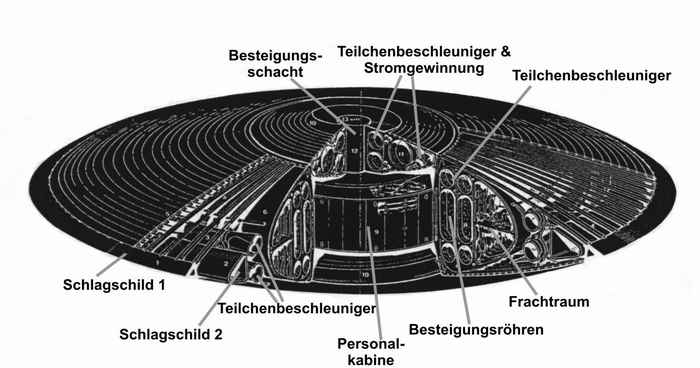
Levitationmaschine mit Hochspannung
Lifter Experimente von Naudin:
Durch eine pulsierende Hochspannung mit bis 30 KV generiert sich ein Magnetfeld Zyklon gemäß der rechten Handregel. im Zentrum des Zyklons generiert sich eine vertikale Helion 2-Strömung.
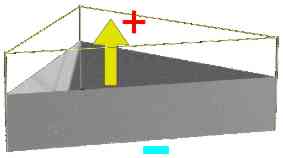
Magnetflussbeschleuniger
 |
Links: Caduceus- Spule
|
Mitte: biffilare- Spule Rechts: Bucking- Spule
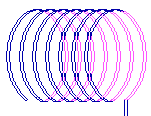
|
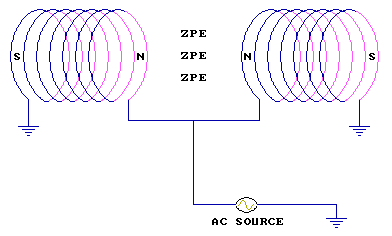 |
Wenn zwei Spulen symmetrisch gegensinnig gegeneinander geschaltet werden, ergibt diese eine nicht induktive Spule.
Wenn durch diese ein Strom fließt, generiert sie ein feines Helion 1 Feld, welches die Spule vor der Raumätherströmung abschirmt. In einen dicht mit Magnetlinien gefüllten Raum kann ein externes Feld nicht eindringen. Es wird als Schild bezeichnet. Das höchste resultierende Feld wird auch als ZPE bezeichnet. Nur dieses wird benötigt. Die Spulen werden als nicht induktiv zusammengeschaltet, das kein elektromagnetischer Fluss störend und beeinflussend entweicht, und die pulsenden Spulen beeinflusst.
Stromgeneratoren
Es gibt mehrere Möglichkeiten den beschleunigten ZPE- Magnetfluss für die Magnetspulen des Stromgenerators zur Verfügung zu stellen.
1. Radium oder andere Zerfallprodukte. (Hendershot , Hubbart)
2. Influenzmaschine, die eine Hochspannung plus einem beschleunigten Magnetfeld erzeugt. (Testatika)
3. Einem Zwirl, eine erweiterte Pyramide. Siehe: Projekte. Zwirl.
4. Ein
elektrisch leitender Permanentmagnet. (Coler)
Oszillator der ZPE
1. Spule meist auf Eisenkern mit Kondensator. (Hendershot, Hubbart)
2. Spule auf Magnetkern. (Coler, Testatika)
3. Vacumröhre als Verstärker oder Schalter (Radar) . (Moray)
4.
Anihilationsreaktor
Die Magnetkerne oder Röhrenverstärker arbeiten als ZPE- Magnetflussbeschleuniger mit pulsierendem Gleichstrom, nicht mit Wechselstrom. Deshalb werden für einen selbstständig oszillierenden Stromgenerator mindestens zwei getrennte Magnetflussbeschleuniger benötigt, die als Brücke wechselnd pulsen.
Gegentaktoszillator mit Vacumröhren: http://www.hcrs.at/VHFOSC.HTM
Parametrische Schwingungserregung mit Spulen: http://www.hcrs.at/PARAMET.HTM
Erregung
1. Die Oszillatoren können sich mindestens als zweier, oder Mehrfachgruppe
abwechselnd gegenseitig pulsen.
2. Die Oszillatoren werden durch einen bewegten Permanentmagnet (rotierend) gepulst. (Motor-Generator)
Die Oszillatoren dürfen nur kurz induziert werden, um ein Magnetfeld und eine Ausgangsleistung zu generieren.
Dann müssen die Oszillatoren berührungslos frei oszillieren können um einen beschleunigten ZPE- Magnetfluss zu generieren. Siehe: Energetisierungsoszillatoren und Magnetflussbeschleuniger.
Alle Stromgeneratoren benötigen eine Erregung durch eine Strahlung, die meistens durch Radon gedoptes Eisen, oder durch schnell bewegte Permanentmagneten erzeugt wird.
Anwendungen
Magnetstromapperat von
Hans Coler

Magnetstromapperat von Hans Coler
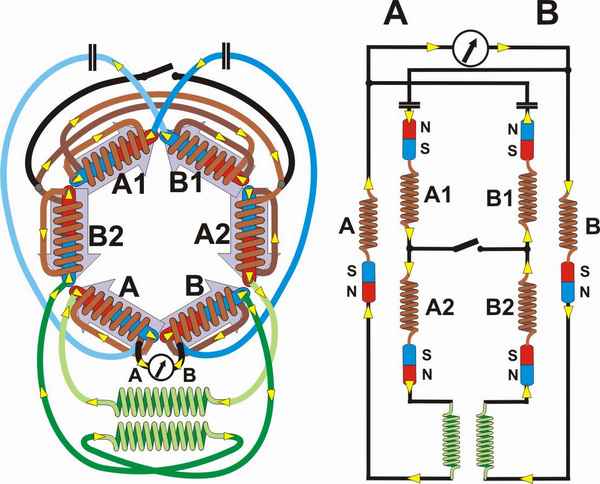
Ein weiteres Beispiel ist der des . In den späten 20er Jahren entwickelte der deutsche Marine-Kapitän Hans Coler diese Konverter mit magnetisch und elektrisch gekoppelten Schwingkreisen. Er erzeugte zwar nur eine geringe Ausgangsspannung, dafür aber einen hohen Strom, so dass eine Leistung von insgesamt etwa 6 Kilowatt entstand. Der Apparat wurde 1926 von Professor M. Klose von der TH Berlin-Charlottenburg und von Professor W.O. Schumann von der TU München geprüft, die bestätigten, dass er einwandfrei funktioniere, jedoch nicht in der Lage waren, zu erklären, wie die Energie erzeugt wurde.

Klose stellte einen Wirkungsgrad von 450 % fest; Schumann fand gar, dass 4,8 bis 6,7 mal mehr Energie herauskam, als in das Gerät hineingesteckt wurde. Eine Täuschung schloss Schumann völlig aus. Kurz vor Ende des 2.Weltkrieges wurde der Coler-Konverter im Auftrag des Kriegsmarine-Kommandos von einem Firmenkonsortium unter Leitung von Siemens weiterentwickelt; nach Kriegsende wurde er vom britischen Geheimdienst beschlagnahmt, der 1946 einen detaillierten, heute teilweise freigegebenen Bericht darüber verfaßte (British Intelligence Objectives Sub-Committee, 1946).
Coler Stromgenerator Tachionator
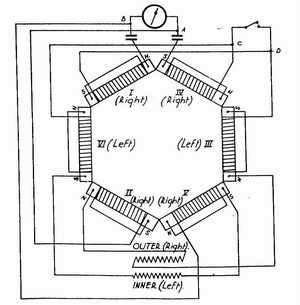
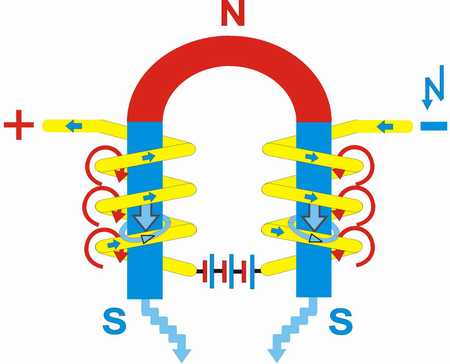
Tachionator
Der 0 - Punkt des Tachionators saugt mit der Geschwindigkeit des
Lichtes und elektrischen Stromes Tachionen an.
Unten drückt der Tachionator gestreckte beschleunigte Magnetische
Kraftlinien mit der Geschwindigkeit des Lichtes und elektrischen Stromes
heraus.
Das Fluggerät besitzt 4 Zyklonen-Tachionatoren
in denen sich ebenfalls die Amplifikatoren für den Antrieb und Steuerung
befindet.
Levitations-Maschine-Ionenantrieb
Oben aus der Mitte strömt aus einem Hohlleiter Elektronen-Beschleunigtes
Magnetplasma.
Das Elektronen-Plasma strömt an den Seiten nach unten und schirmt die
Gravitationsströmung ab.
Das Elektronen-Plasma wird unten am Tachionator wieder angesaugt.
Die Ionen reiben an der Gravitationsströmung, und treiben das Raumschiff an.
Ein geladener Kondensator bewegt sich in der Gravitationsströmung von
Minus nach Plus.
1933 schematics of the
Coler Converter from a British Intelligence document.
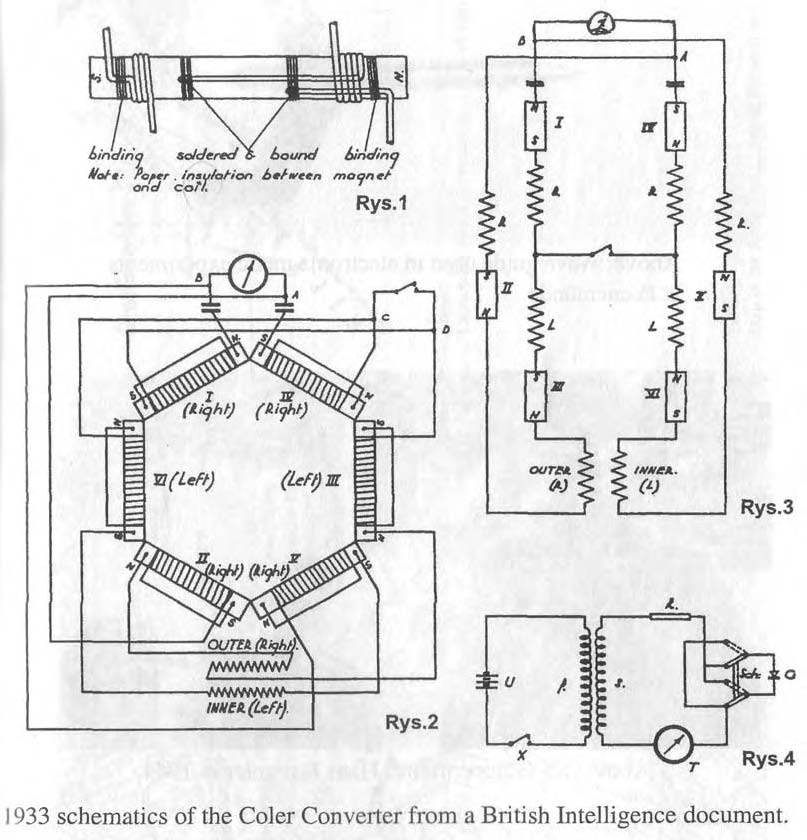
Technik
Die gelben Pfeile zeigen den Stromfluss. Die großen violetten Pfeile zeigen den Fluss des beschleunigten ZPE-Magnetfeldes.
Der Stromgenerator besteht aus sechs
hexagonal so angeordneten elektrisch leitfähigen Alnico- Magneten das der
magnetische Fluss geschlossen ist.
Die Spule induziert durch Gleichstromimpulse auf den Kern einen magnetischen
Fluss, der Kern generiert daraus einen beschleunigten ZPE- Magnetfluss.
Der Kern
und die Wicklung sind elektrisch in Reihe geschaltet, um den beschleunigten
ZPE- Magnetfluss zu beschleunigen.
Siehe: elektrischer Leiter im Magnetfeld.
Die Spulen
müssen mit dem Magnetstab auf höchsten ZPE- Magnetfuß abgestimmt werden.
Dazu wird jede Spule einzeln vor und nach dem anschleißen abgeglichen.
Die Daten der Spulen und Magnet müssen so gut wie möglich übereinstimmen,
weil sich Spule A1(B1) zu A2 (B2) als nicht induktive Spule gegenüberstehen.
Die Spulen sind versuchsweise zur Innenseite des Kreises mit Ferritblöcken
abgeschirmt, damit das Pulsirende Magnetfeld die anderen Spulen nicht
beeinflusst.
Die zwei verschiebbaren Luftspulen koppeln den Kreis A mit dem Kreis B. Die
Kopplung der der Luftspulen (grün) bilden zu den Kondensatoren einen
Oszillator, der den Kreis A und den Kreis B miteinander zum schwingen bringt.
Beim Start wird der Kreis A mit dem Kreis B zusammengeschaltet, und die
Magnete werden so dicht wie möglich zusammen gefahren. Dann werden mit einer
Batterie über einen Taster Impulse in eine der Koppelspulen eingespeist.
Wenn sich der Oszillator energetisiert hat steigt die Amplitude und die
Magneten werden etwas (bis zu 9mm) auf Resonanzabstand und besten Brennpunkt
der ZPE-Welle auseinander gefahren. Bei höchster Amplitude wird der Schalter
geöffnet.
Wenn der Generator nicht startet, oder schlecht läuft, sollte eine kleine
Gleichspannung seriell in beide Kreise zugeschaltet werden. Die
Spannungeinspeisestelle muss mit einem Kondensator ab 330 µF parallel
geschaltet werden.

Bild links: Eine Version mit nur einem Magnetstab. Die zwei Wicklungshälften
sind nur zur Darstellung der Anschlüsse an den Magnetkern nicht als
durchgehende Wicklung, sondern als Schnitt gezeichnet. Die Windungszahl darf
nicht zu hoch sein.
Bild rechts: Starthilfe. Impulseinspeisung mit einer Batterie einen
Transformator auf die nicht induktive Spule.
Die Diode wird mit dem Polwechselschalter gemäß dem Fluss der
angeschlossenen Magnetspule gepolt, und richtet die Impulse gleich.
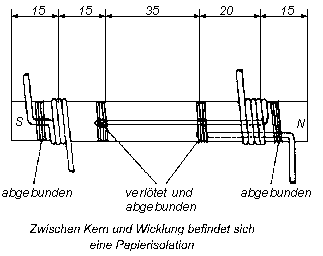
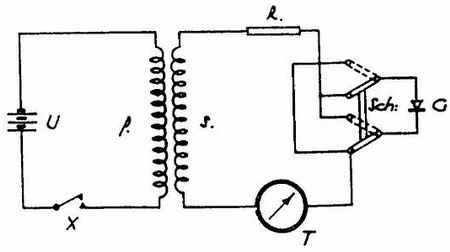
Bild links: Nachbildung vom Hc&Rs Labor
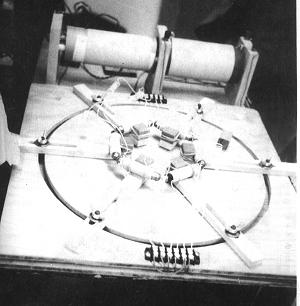
Zyklonengenerator Nachbau von Walter Thurner
An diesem Generator wurde noch kein Strom abgenommen, aber
ein generiert sehr starkes störendes Feld, weil der magnetische Kreis offen
ist. Die beiden Spulen sind auf einen elektrisch leitenden Berillium
Permanentmagnetstab nebeneinander gewickelt. Zu den zwei Spulen ist eine
Gleichspannung in Serie geschaltet, die den Kern magnetisiert und dopt.

Der Stromerzeuger
Dieser, im Vergleich zum Magnetstromapparat
wesentlich interessantere Apparat ist leider nicht so genau beschrieben,
auch liegen mir leider keine detaillierten Zeichnungen vor. Aus [1] ist zu
entnehmen, dass das Gerät aus einer Anordnung von Magneten, flachen Spulen
und Kupferplatten besteht und von einer kleinen Batterie gespeist wird. Es
existiert ein Primär- und ein Sekundärkreis. Die Energieabgabe des Systems
ist nach verschiedenen Berichten kompetenter Wissenschaftler mehrere Male
größer als die Leistung, die über den Primärkreis aus der Batterie entnommen
wird.
[1] fasst den Aufbau und die evtl. Wirkungsweise wie folgt zusammen:
- Das Basisprinzip ist, dass ein
Elektron nicht nur als negativ geladenes Teilchen betrachtet werden kann,
sondern auch als magnetischer Südpol. Das Grundelement ist das eines
offenen Sekundärkreises, induktiv gekoppelt mit einem Primärkreis. Das
neue Merkmal ist, dass Kapazitäten über Permanentmagneten mit dem
Sekundärkern wie folgt verbunden sind:

Es wird behauptet, dass beim Einschalten des Primärstromkreises eine Ladungstrennung auftritt, d.h. M1 wird z.B. positiv und M2 negativ aufgeladen, und diese Ladungen werden "magnetisch polarisiert", wenn sie sich formieren, wegen der Anwesenheit der Magnete. Beim Ausschalten des Primärkreises fließt ein "Rückstrom" im Sekundärkreis, aber die Magnete "üben keinen polarisierenden Effekt auf diese Umkehrung aus" - Zwei dieser Grundelemente werden
nun zusammengefügt und bilden ein Doppelsystem oder -stufe, wobei die
Platten dicht zusammen in parallelen Ebenen liegen sollen wie hier gezeigt:
Die Sekundärwicklungen sind beide genau gleich und so gewickelt, dass beim Einschalten der Primärspule die Elektronen in der Sekundärspule von P1 nach P2 und F1 nach F2 fließen. Es wird dann festgestellt, dass das System F1 - F2 lediglich einen Induktionseffekt hat und nutzbarer Strom im System P1 - P2 entsteht. - Eine einzelne Stufe ist ineffektiv, aber zwei Stufen, die so verbunden sind, dass die Anzahl der effektiven Nord- und Südpole gleich ist, stellen eine arbeitsfähige Anordnung dar. Weitere Doppelstufen können hinzugefügt werden, um höhere Ausgangsleistungen zur Verfügung zu stellen.
- Weiterhin wird festgestellt, dass, so wie normale Elektronen aus einer Batterie fließen und und eine Induktion hervorrufen, wenn der Kreis geschlossen oder geöffnet wird, "Raumelektronen" von "abstoßenden Räumen" zu "anziehenden Räumen" fließen, aber es war mir nicht möglich, dieser Theorie weiter zu folgen.
Die Formulierungen sind teilweise nicht ganz
klar und erst recht ergeben sie vom Standpunkt der klassischen
Elektrizitätslehre keinen Sinn. Trotzdem arbeitet das Gerät offenbar, denn
es wurde mehrfach überprüft. [1] enthält mehrere Berichte über ausführliche
Messungen und deren Ergebnisse, die kaum einen Zweifel lassen.
An der Konstruktion scheint es im Laufe der Jahre mehrere Änderungen
gegeben zu haben, denn die Beschreibungen der einzelnen Berichte weichen
leicht voneinander ab.
Aus der Beschreibung im Bericht Prof. Schumanns (in [1]) lässt sich
folgendes entnehmen:
Der Stromerzeuger enthält prinzipiell zwei parallel geschalteten,
magnetisch gekoppelten Spulen. Eine dieser Spulen ist aus Kupferblechen
gefertigt und wird im Bericht als Plattenspule bezeichnet. Die andere
Wicklung besteht aus einer Anzahl dünner parallel geschalteter isolierter
Drähte, wird als Spulenwicklung bezeichnet und verläuft in kleinen Abständen
parallel zur Plattenwicklung. Die Spulen sind in je zwei Hälften angeordnet,
entsprechend einem bifilaren Wickelsystem. An die Anfangspunkte der
Wicklungen beider Spulen sind jeweils Batterien angeschlossen, an den (Parallelgeschalteten)
Enden die Stromabnehmer. Außerdem befinden sich zwischen parallelen
Windungen der beiden Hälften der Plattenspule Zwischenverbindungen aus
Eisenstäben, die mit Silberdraht an die Windungen angeschlossen sind. Diese
Stäbe sind ebenfalls mit einer Wicklung versehen, die von einer weiteren
Batterie gespeist wird und die Stäbe magnetisiert. Diese Wicklung wird im
Bericht als Erregerwicklung bezeichnet. Außerdem wird noch erwähnt, dass die
Form der Spule die eines langen schmalen Rechtecks war.
Zwirl 8
Bild links: Eine erweiterte Pyramide. Eine Kegelspule ist in die Pyramide eingewoben. Der beschleunigte Magnetfluss wird von den geraden Drähten (grün) auf die Kegelspiralspule (rot) übertragen. Dadurch wird der Zwirl zusätzlich beschleunigt. Der untere Ring Ausgang des Zwirls wird in Reihe mit der Elektrolysezelle geschaltet. Das ganze wird mit pulsierenden Gleichstrom gespeist. Der Gleichstrom mit einem beschleunigten Magnetfluss addiert.

Bauen: Man baut als Stütze zuerst eine Pyramide. Dann wird die Pyramide erweitert. Die Drahtspirale wird zur besseren Festigkeit durch die Stäbe gewoben.
Geplant ist der Zwirl als mechanisch Drehend.
Spulen-Zwirl
Das Plasma wird mit ZPE- Magnetflussbeschleunigern (siehe unten) enorm beschleunigt. Bild rechts: ZPE- Magnetflussbeschleuniger in einer Levitationsmaschine als Amplifikatoren. Es können auch zur verstärkung mehr als 3 Amplifikatoren verwendet werden.
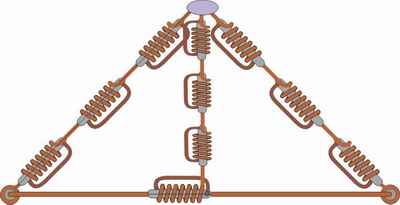
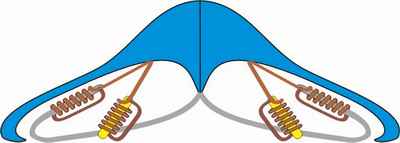
Charge Density Influences
Time
(c) Robert Neil Boyd
[R. N. Boyd]: Regarding charge compression, from "The Theory of Groups
and Quantum Mechanics" by H. Weyl, charge density changes the rate of time
so that: delta Egrad is proportional to delta Tr where Egrad is charge
density and Tr is time rate. More precisely, tau = (sin theta)^-m e^im theta
(This is the expression of the conservation of time.) Egrad = -e Sgrad
Egrad = & wave quantity/& tau + wave quantity
(& denotes partial derivative) (This has been verified experimentally
for rotating masses.) !!
--------------------------------------------------------------------------------------------
Since the foundational equation for gravity contains a charge term, "Q", then mass, inertia, and charge density are all related to time. We then have entities such as mass-time and charge-time. In addition, as I have pointed out before, magnetic moment/angular momentum = charge/mass !!!
Then magnetic moment = angular momentum (charge/mass)
Then magnetic moment (charge/mass) => angular momentum (we will use omega here)
Now we have several varieties of transformations in addition to the
Lorentz transform and the Moebius transform: omega x, omega y,
omega z represent the rotations of charge and rotations of inertia. mega xy,
omega xz represent screw displacements omega yz represents
simultaneous rotations of charge + inertia omega xyz represents
charge reflection
The Poynting vector can be described by the rotation group (4,2), in addition to the normal description in a six dimensional velocity phase space. In a 4D manifold, there are 6 rotation groups. So, the quaternionic transformation groups of the 4D polytopes may represent the origination of the various forces and fields.
Further, it appears that we live in a space that contains topological torsion. Due to this torsion, the topology of our universe changes smoothly, and continuously. This continuous change of the topology due to torsion is not reversible (Keihn 1977c). This continuous change of the topology due to topological torsion, may be the source of time, the origination of quantization, and the origination of particle spin. It is possible that time is quantized, and thus the universe would appear as a series of discrete jumps, or "time quanta".
If this is true, time rate can be used to measure the torsion factor of the topology. Since, time rate is proportional to charge density, it may be possible to manipulate the topology by the appropriate application of rotations of charge+inertia.
Of further interest is the quantum property of the scattering of light and particles by the intersection of #virtual quantum waves# in a conducting lattice. (We may consider the physical vacuum as a conducting lattice media, but this especially applies in the case of resident particles in the given volume, for example, in a [rotating] plasma.) This is given by:
[2 pi k^-1 N delta x Re f(0)]^2
The angle of the wave relative to the scattering centers causes various scattering resonances and phase shifts, and the DeBroglie wavelength and kinetic energy density will be altered by the scattering media. Quantum scattering density increases as we approach the center of any conductive lattice.
Phase shifts are produced by any repulsive (negative) or attractive (positive) potentials. Repulsive regions will cause retardation of the of the phase, while attractive regions cause acceleration of the phase.
To simplify this discussion, we can say that where we have a charged region, the electric field potential causes a phase shift proportional to the magnitude and sign of the charge.
If light has no charge, why then should its phase be observably affected by any potential? (I have brought this concept of optical charge up before.)
On another topic, I think that the quantum "event potential" is identically Sheldrake's morphogenic field".
3D Wave Collapse in Nonlinear Medium with a Normal Dispersion
Please note that we have a 3D electrostatic wave in the electric rocket. The dielectric material and the ionized air plasma are both nonlinear media. Look what the guys say. I think it would also apply to our gravity warp (oh sorry, electrostatic wave collapse:-) application:
3D Wave Collapse in Nonlinear Medium with a Normal Dispersion Alexander Litvak, Vyacheslav Mironov, Nina Zharova (Institute of Applied Physics, Russian Academy of Science, Nizhny Novgorod, Russia)
New features of 3D wave packets nonlinear dynamics are studied for a medium with normal group velocity dispersion that is described by nonlinear evolution type equation with a hyperbolic spatial operator. It is shown analytically and by computer simulations that wave packets with initial hyperbolic symmetry (of the type of hollow axially symmetric distributions) are collapsing in the processes of self-contraction and fall to the axis of the packet with a singularity formation (infinite intensity growth) at the wave packet centre. Collapse stabilization due to nonlinear (multiphoton) absorption or refractive index nonlinearity saturation are studied.
Faraday's observed that: 'Electrical capacity is to gravity as inductance is to magnetism'. .....If faraday is correct then the energy stored in the capacitor is in the form of a GRAVITATIONAL field. Townsend Brown also found in charged capacitors that weight reduction only occurs when the positive plate is upside to the negative plate. .... If the negative plate is above then the device increases in weight . Dan Davidson et. al. then observed that the AMOUNT of weight change is greatest if a SMALLER CAPACITOR is nested under the larger!? The obvious next experiment is to nest capacitors in the (Golden) ratio of recursion/embedding, to PRODUCE OPTIMUM CHARGE COMPRESSION & THEREFORE THE GREATEST GRAVITY!(Capacitors in Phi array - produce 'ion effect')
In other words, no 'rocket scientist' is required to solve the unified field, merely understanding the geometry of compression. It stands to reason if you compress charge you store the inertia of that charge, which physics then calls 'mass'. What they missed was the way waves used PHI recursion to send a portion of that inertia through light speed at the implosion center, to produce the magnetic monopole which was Einstein's name for gravity.
-------------------------------------------------------------------------------------------
Magnetic monopoles (excited states of neutrinos/antineutrinos??) was Einstein's name for gravity??? COOL!! An electrostatic wave collapse do produce a (tachionic?) neutrino beam. So it is really a GRAVITY WARP DEVICE!! WOOW!!!
Later I will quote a paper published in the Electric Spacecraft Journal where a PhD candidate from the university of Karlsruhe in Germany produced a TACHIONATOR based on the Morton effect which considers spark discharges as Dr. Thomas Townsend Brown considered too.
-------------------------------------------------------------------------------------------------------
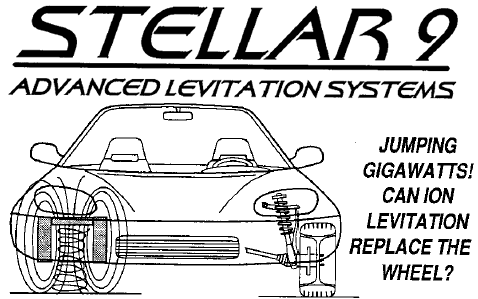
Ion-Containment Levitation Strategy
One of the big drawbacks to Lifter technology is the amount of power-required to propel an object. Ion-containment levitation would be a simple "cheat" to circumvent the high amounts of power involved.
Ion-containment could be considered similar to the hovercraft in terms of performance and operation, although it would undoubtedly serve in a much different range of application, at least initially.
Ion-containment provides a ground-effect that should theoretically have a much greater lifting efficiency than the Field-Effect device would have on its own. The ion-containment apparatus effectively creates a mini-tornado of ions below the craft and rides at the crest of that tornado, which only requires a minimal current to maintain once initiated.
Levitation System Schematic
A description of the ion-levitation electronics system and a detailed overview of an ion-containment coil.
Ion-Column Schematic
This ion-column levitation idea maintains a stable levitation height by using a feedback system.
Bill Butler revitalised the Hover-technologies name in an abbreviated form, and diversified into geomagnetic levitation, paramagnetic-gas experimentation, electrostatic-repulsion levitation, and intensified research into ion-containment levitation.
The goal of the ion-containment strategy is to create a cushion of ions travelling in a circular orbit beneath the hoverboard, which should tend to support more weight with a higher efficiency than a conventional ion-drive would.
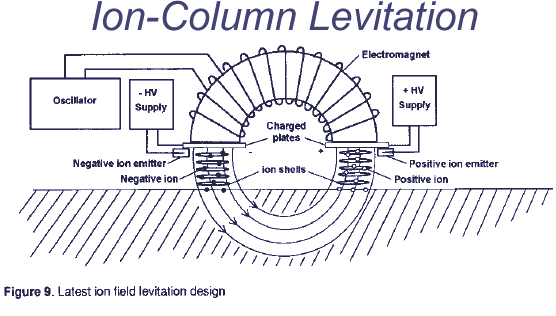
Lorentz Force
Ions are charged particles, and as such they interact with a magnetic field while in motion. The hovertech ion-containment strategy relies on Lorentz-force to contain the ions in a circular orbit to maximize efficiency -- Lorentz force is the same force that makes the electric motor perform work.
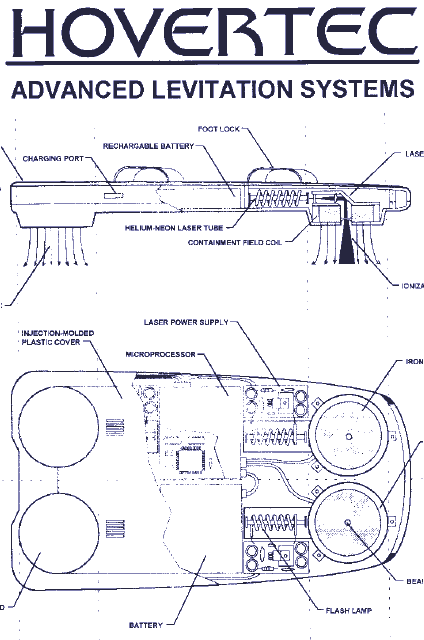
Çetin BAL: Yerçekiminin yenilmesinde bir çok deneysel fizikçiden, araştırmacılardan manyetik ve elektrostatik alanların kullanımına dair çok değişik görüşler fikirler ve çizimler ortaya sürülmektedir. Bu sistemlerin çalışabilir olmamasına rağmen nasıl patent alınabildiğini yada çalışmayan sistemlerin nasıl tescil edilebildiğini anlamak güç! Bunun yanında çok ilgisiz kavramların karıştırılarak bir araya getirilerek çok uç ve absürd nitelikte ''yerçekimini, uzay ve zamanı'' aşabilecek araçların sözde şematik olarak ortaya konması oldukça ilginçtir. Ki bence bunların birçoğu bilimsel temeli olmayan tasarımlardır. Amerikada ve Avrupada kendi vatandaşlarından gelen çok küçükte olsa orijinal bir fikir bir hayal hemen sahiplenilmekte ve toplumca saygı görmektedir. Ki bu amatör araştırmacılardan gelen sadece bir fikir bir düşünce olsa bile! Ben kendi adıma askeri anlamda teknolojiler içinde bu tarz teknolojilere doğru ilginç keşiflerin yapılmış olabileceğini ama özel sektör alanında amatörler arasında gerçekten çalışan bir UFO modelinin (elektromanyetik uzay araçlarının) yapılabildiği konusunda tereddütlerim olduğunu söylemeliyim.
Magnetic monopole spacecraft
Abstract
A spacecraft propulsion system that utilizes a dual method of providing lift on the hull by means of magnetic monopoles and electromagnetic spacetime curvature pressure.
A spacecraft propulsion system consisting of the following components:
a lower hull made of aluminum sheet having a shallow spherical profile; a
circular flat sloping hull made of aluminum sheet attached to the top of
the lower hull on the periphery; an electrically-insulated plastic-molded
tubular cylindrical hull containing slots for mounting an array of radial
microwave waveguides, attached to top of the flat sloping hull; a
hemispherical cupola in the shape of a dome made of aluminum sheet mounted
on top of the insulated cylindrical hull; an array of rectangular
microwave waveguides mounted in the waveguide slots of the cylindrical
hull; a high-voltage alternating current transformer with one side
electrically attached to the upper dome and the other side electrically
attached to the flat sloping hull; and a frequency generator and amplifier
to drive the microwave waveguides.
This invention is a spacecraft propulsion system that generates a
field of wormholes which are threaded with a magnetic field. Acting as two
attracting magnets, the spacecraft's north magnetic field is attracted to
the constantly regenerating south magnetic monopoles of the wormholes
which provides lift on the hull.
The concept of the wormhole involves a new type of scientific
thinking involving the creation of a gateway between our spacetime and
that of a hyperspace co-dimension. The gateway is created
electromagnetically as shown by my patent applications
Rotating Magnetic
Vortex Generator, Magnetic Vortex Wormhole Generator, and Sulfur 8
Wormhole Generator. The gateway can also be created ultrasonically through
bubble cavitation as shown in my patent application Cavitating Oil
Hyperspace Energy Generator.
In one experiment, smoke was blown through
one side of the coil of the magnetic vortex wormhole generator and no
smoke came out the other side. The smoke was blown through the wormhole
into another dimension.
By firing the microwaves at right angles to the B field, negative
energy is created over the hull. The negative energy and spacetime
curvature pressure generate wormholes between space and hyperspace.
Because hyperspace has a low speed of light and positive gravitational
potential, low density hyperspace energy flows through the wormholes and
onto the hull. The effect of the hyperspace energy is to lessen the mass
of the vehicle and to increase the strength of the electromagnetic fields.
Because the resistance of hyperspace is less than the resistance of space,
electrons spiral down the wormholes into hyperspace. This creates a
magnetic field through the wormhole with one pole in our dimension and the
other pole in hyperspace. Thus a field of magnetic monopoles is created
over the hull.
The Magnetic Monopole Spacecraft
He's a hyperinventing hypermachine! Hot on the heals of his Triangular
and Photon spacecraft, John Q. St. Clair brings us yet another new
propulsion design: The Magnetic Monopole Spacecraft, which is...
a spacecraft propulsion system that generates a field of wormholes which
are threaded with a magnetic field. Acting as two attracting magnets, the
spacecraft's north magnetic field is attracted to the constantly
regenerating south magnetic monopoles of the wormholes which provides lift
on the hull.
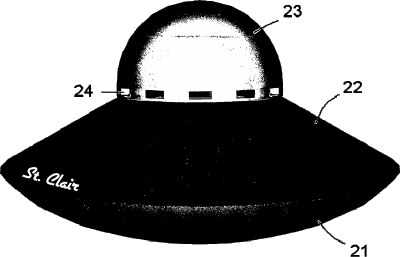
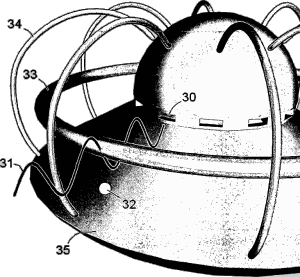
Of particular interest here at ZPi, check out these key system components:
... a lower hull made of aluminum sheet having a shallow spherical profile [21]; a circular flat sloping hull made of aluminum sheet attached to the top of the lower hull on the periphery [22]; ... a hemispherical cupola in the shape of a dome made of aluminum sheet [23] ...
The thing's a flying AFDB with built in basal protection! This could be the ideal vehicle for paranoid space exploration.
But more on the fascinating method by which the MMS works...
[24] in FIG. 11 is "an electrically-insulated plastic-molded tubular cylindrical hull containing slots for mounting an array of radial microwave waveguides", which are needed to produce a radial electromagnetic field of microwave beams [30 in FIG. 15, right] which interact with the circular magnetic field [33] produced by the oscillating magnetic flux density field [34] to generate negative energy [32] that in turn generates the field of wormholes between space and hyperspace over the hull [35] that cause the lift.
The Starship Builders (Speculation on UFO Propulsion methods by Physist)
Stardrive | FR Post 3-15-03 (Article update 1999) | by Kim Burrafato
Posted on 03/14/2003 6:19:01 AM PST by vannrox
The Starship Builders
by
Kim Burrafato
In UFOs and the New Physics, we discussed some of the daunting problems in applying terrestrial rocket propulsion principles to any hypothetical models of UFO propulsion. A lot has happened since that article?s publication over two years ago.
It seems we?re getting almost weekly reports of newly discovered extrasolar planetary systems. What was once highly speculative, is now commonplace. Obviously, our previous estimates of the number of stars with possible planetary systems will be revised dramatically upwards.
Then there is the recent announcement from a distinguished British research team, that they also had found unambiguous traces of microbial life in Martian meteorite fragments. Combine that with the proliferation of newly discovered extrasolar planets, and one has the makings of a scientific revolution. In this extraordinary context, the subject of UFOs suddenly takes on significant new meaning.
Despite all this stunning news, we?re still left at the point we were at the end of the last article: If UFOs are real, then how do they get from there (where or whenever that may be), to here?
Since the publication of physicist, Miguel Alcubierre?s, landmark paper "The Warp Drive: Hyper fast travel within General Relativity," in the journal Classic and Quantum Gravity(11, L73, 1994), the idea of hyperfast space travel has become a hot scientific topic no doubt fueled in part by the recent discoveries of Martian microbe remnants and extrasolar planets.
The Alcubierre Warp Drive is purely a consequence of the subtleties inherent in Einstein?s General Theory of Relativity. Spacetime, the union of one time and three space dimensions, is dynamic according to General Relativity. It can be twisted, deformed, and possibly even engineered by concentrations(random or selective) of mass/energy. Alcubierre?s Warp Drive alters spacetime in such a way that the region directly in front of the ship contracts, while the region directly behind the ship expands. The net effect of this is that the ship is propelled on a weightless geodesic path through spacetime.
Alcubierre explains his reasoning in the following paragraphs. I quote
them in full because they are essential to the rationale of this article
"The basic idea can be more easily understood if we think for a moment in the inflationary phase of the early Universe, and consider the relative speed of separation of two comoving observers. It is easy to convince oneself that if we define this relative speed as the rate of change of proper spatial distance over proper time, we will obtain a value that is much larger than the speed of light. This doesn?t mean that our observers will be traveling faster than light: they will always move within their own light cones.
"The enormous speed of separation comes from the expansion of spacetime itself. This superluminal speed is very often a source of confusion. It is also a very good example of how an intuition based on special relativity can be deceiving when one deals with dynamical spacetimes."
The next paragraph is the crystallization of his warp drive idea.
"The previous example shows how one can use an expansion of spacetime to move away from some object at an arbitrarily large speed. In the same way, one can use a contraction of spacetime to approach an object at any speed. This is the basis of the model of hyper fast space travel that I wish to present here: create a local distortion of spacetime that will produce an expansion behind the spaceship, and an opposite contraction ahead of it. In this way, the spaceship will be pushed away from the earth and pulled towards a distant star by spacetime itself. One can then invert the process to come back to earth, taking an arbitrarily small time to complete the trip."
Alcubierre does point out in his abstract that "just as it happens with wormholes, exotic matter will be needed in order to generate a distortion of spacetime like the one discussed here." We will return to the subject of exotic matter later in this article.
The key point is that Alcubierre?s drive eliminates the nagging problem of time dilation, also discussed in the previous article. This would go a long way in making interstellar travel a practical reality. You could leave on a Saturday morning to go on a hundred light year journey(or thousand, for that matter), and return the following Saturday(or the same Saturday) to find everyone you know and love has aged no more or no less than yourself. Nice. If it works.
Alcubierre works this seeming bit of gravitational magic by creating what he glibly calls "a simple metric that has precisely the characteristics mentioned above." His paper is actually one of the first theoretical realizations of "metric engineering," an idea first advanced by Russian Nobel Laureate, Andre Sakharov and American Nobel Laureate, T.D. Lee, and further developed by physicist Hal Puthoff and others.
The way to metric engineering and the creation of exotic matter may lie in the energetic quantum vacuum. Modern Quantum Electrodynamics shows that the vacuum is not a void, but rather the opposite: an infinite reservoir of virtual particles and zero point energy. These zero point energy fluctuations of the vacuum lead to such real, measurable effects as the Casimir force, the Lamb shift, the Van der Waals chemical binding forces, and a number of other measurable effects.
Harold Puthoff is one physicist who has been exploring this particular area for some time. Puthoff is a theoretical and experimental physicist specializing in fundamental electrodynamics, and Director of the Institute for Advanced Studies at Austin. His research ranges from the study of quantum vacuum states as they apply to the stability of matter, gravitation, cosmology and energy research, to laboratory studies of innovative approaches to energy generation. A graduate of Stanford University, he has published over 30 technical papers in the areas of electron-beam devices, lasers and quantum zero-point energy fields, and is co-author of a textbook, Fundamentals of Quantum Electronics (Wiley, 1969).
In a paper published in the Feb 1, 1994 Physical Review A, Puthoff, along with Bernard Haisch of Lockheed Palo Alto Research Laboratory, and Alfonso Rueda of California State University at Long Beach connect zero-point vacuum energy to inertia ? that is, the tendency of moving masses to remain moving, and masses at rest to remain at rest.
You?re a little kid standing up in your red Radio Flyer wagon, when your pal suddenly pulls the wagon forward and you?re rudely flung onto the ground. You might have blamed your friend for his lack of good judgment, but it was actually inertia that catapulted you off the wagon. Scientists have been trying to figure out exactly what inertia is and how it arises ever since Galileo came up with the concept in the 17th century. Even Einstein, who believed that inertia was due to the arrangement of matter in the Universe, was unsuccessful in theoretically describing the true nature of inertia.
In their paper, Puthoff, Haisch, and Rueda propose that inertia is the result of the zero-point fluctuations of the hidden quantum vacuum energy that surrounds us. It is this omnipresent vacuum energy that the researchers believe resists the acceleration of mass, thus giving rise to what we call inertia. Their idea was based in part around an earlier and long forgotten idea of Sakharov, linking the force of gravity to the vacuum zero-point fluctuations. If the nature of inertia can ever be understood, the way will have been paved for it to eventually being controlled. At that point we will have obtained that Holy Grail of science fiction, the inertialess star drive.
This work has additional relevance to the Alcubierre paper. In a more recent publication entitled "SETI, the Velocity-of-Light Limitation, and the Alcubierre Warp Drive: An Integrating Overview" (Physics Essays, volume 9, number 1, 1996), Puthoff extends Alcubierre?s work to show that "Alcubierre?s result is a particular case of a broad, general approach that might loosely be called ?metric engineering,? the details of which provide further support for the concept that reduced time interstellar travel, either by advanced extraterrestrial civilizations at present, or ourselves in the future, is not, as naïve consideration might hold, fundamentally constrained by physical principles." Puthoff?s expression "metric engineering" is not to be taken lightly. Just as the internal combustion engine drove the Industrial Revolution and human expansion around the globe, metric engineering would drive a new human interstellar society into the furthest reaches of the space. Heady stuff.
"The fact that the vacuum constitutes an energy reservoir," as Puthoff says, doesn?t mean it?s going to be easy to tap into it. There are some promising avenues of approach, though. The Casimir force mentioned earlier, is an attractive force between two very flat, conducting plates placed closely parallel to one another. Fewer electromagnetic waves can fit between the plates than outside them. As a result, the electromagnetic zero-point pressure is smaller between the plates than outside them. The result is an attractive force. The total vacuum energy density between the plates is negative, that is, less than compared to that outside them. Anything that has such a lower, or negative energy relative to the overall vacuum density can be considered exotic matter.
Physicist Robert L. Forward published a paper entitled "Extraction of electrical energy from the vacuum"(Phys. Rev., B 30, 1700, 1984), that attempts to exploit the Casimir plate effect. Forward has done considerable work in the theoretical and engineering aspects of matter/antimatter annihilation propulsion, including an ingenious design for an antihydrogen ice crystal powered starship. His vacuum energy extraction paper uses the Casimir effect as a kind of vacuum electrical generator. Again, two identically charged plates are placed close together. Like charges repel something known as Coulomb repulsion. However, the stronger Casimir attractive vacuum force overcomes this Coulomb barrier, and causes the plates to be drawn together in a collapsing motion. This in turn, confines the electrical charge distribution to an ever decreasing volume. The end result is that zero-point energy or Casimir energy is converted into potential electrical Coulomb energy, which can then be extracted in a number of straightforward ways.
The problem with this scheme is that such a Casimir generator is a one shot device. You have to put as much energy into the device to get the plates to return to their original separated positions, as you get from their attractive collapse. Considering the normal operating inefficiencies in any kind of electro-mechanical device, such a device remains a long way from operating in any kind of energy "over unity, " or "break even" mode, for that matter.
Attempts are being made to work around that problem. In a paper entitled "The energetic vacuum: implications for energy research"(Speculations in Science and Technology, Vol 13, No. 4, page 247, 1990), Puthoff extends Forward?s idea of a vacuum energy generator.
"Let us carry this one step further, however. If one could arrange to have an inexhaustible supply of such devices, and if it took less energy to make each device than was obtained from the Casimir-collapse process, and if the devices were discarded after use rather than recycled, then one could envision the conversion of vacuum energy to use with a net positive yield. Although almost certainly not achievable in terms of mechanical devices, a possible candidate for exploitation along such lines would be the generation of a cold, dense, non-neutral(charged) plasma in which charge condensation takes place not on the basis of charged plates being drawn together, but on the basis of a Casimir pinch effect. Such an approach would constitute a ?Casimir-fusion? process, which in its cycle of operation would mimic the nuclear fusion process." Puthoff then goes on to say that he knows of "programs in the United States, the Soviet Union and other countries to explore just such an approach on an experimental basis."
Yet imaginative efforts continue in designing propellant based starships. One of the better examples is the ICAN II web site at -
http://antimatter.phys.psu.edu/ICAN-II_Paper/pictures/ICAN-II_System.html
This ingenious scheme incorporates an enormous hybrid particle accelerator around the actual starship itself, continually generating antimatter fuel while in flight. Again, nice if it works. But that still doesn?t get around the time dilation problem. Try this site -- http://sunsite.unc.edu/lunar/ssdengr.html -- for a good overview of various starship propulsion schemes and designs. Despite all the ingenuity, always boils down to the fact that propellant type "rockets" - no matter what the fuel - don?t cut the interstellar mustard when it comes to truly rapid transit. You have to be able to tweak the spacetime metric itself so you can at least come back and play with the dog.
Of course, this entire discussion centers around some basic human assumptions. It?s still conceivable that interstellar space could be populated with societies who, although incapable of manipulating spacetime, are technologically sophisticated enough to carry their unique, life sustaining environments with them at sub-light speeds, and thrive while doing it. But it would be hard to envision contemporary human society ever adapting to such an alien, nomadic lifestyle.
Another interesting and potentially important propulsion development are the so-called "gravitational shielding" experiments. In these experiments small weights are suspended by extremely sensitive strain gauge devices. Placed closely underneath are rapidly rotating superconducting ceramic discs, which in turn are in a state of levitation due to the superconducting Meissner effect. It has been found in a number of different experiments that a significant fraction of weight is lost from the suspended materials. The effect was first discovered by Tampere University of Technology physicists E. Podkletnov and R. Nieminen, and published in paper entitled "A Possibility of Gravitational Force Shielding by Bulk YBa2Cu307-x Superconductor"(Physica C 203, 1992, pp 441- 444).
Podkletnov later published a second paper with colleague A.D. Levit, "Gravitational Shielding Properties of Composite Bulk YBa2Cu307-x Below 70C Under Electro-magnetic Field"(Tampere University of Technology Report MSU-95 chem, January 1995). This paper provides even stronger evidence for the weight loss effect. In this 2nd experiment, samples of different composition and weight (10-50grams) were placed at distances of 25mm to 1.5 meters from the rotating disk. The resultant mass losses went as high as around 2% -- undeniably a statistically significant amount.
Even more interesting, is the fact that NASA is reported to be conducting, or about to conduct similar gravity shielding experiments. Scientists Ning Li and D.G. Torr at the University of Alabama, Huntsville, have written a number of papers in major journals on the relationship between superconductors and gravitation. It?s not hard to understand why NASA would be interested in the subject. Although other researchers have duplicated these findings, no accepted theory of this new phenomenon has yet to emerge.
More than one reputable physicist has gone on record as saying it?s physically impossible for there to be a direct "electro-gravitic" coupling of such a large magnitude, according to the standard classical General Theory of Relativity when combined with Maxell?s electromagnetic field equations.
"However, there are some hints as to what this effect might actually be," says physicist Jack Sarfatti. "Superconductors have giant quantum wavefunctions. Which means they have large quantum forces exerted on them. The question is: will these large quantum forces distort the spacetime metric in a non-classical way? So, the Finnish experiments might actually be a new kind of giant quantum effect. There is one good phenomenological clue. Thin films of superfluid helium creep vertically up the sides of open beakers, in blatant defiance of the gravitational force. Nevertheless, the jury is still out on the gravitational shielding phenomenon."
NASA?s level of interest in exotic new energy sources and propulsion methods is such that the agency established a landmark research program in July 1996. The following program summary was put out by Marc G. Millis of the NASA Lewis Research Center in Cleveland, Ohio. I quote it in its entirety.
"NASA?s Breakthrough Propulsion Physics Program
Sep 13, 1996
"In July, 1996, a small new NASA research program was established to seek the breakthroughs that could one day revolutionize space travel and enable interstellar voyages. This program, called "Breakthrough Propulsion Physics," is led by Marc G. Millis of NASA?s Lewis Research Center and is a part of the comprehensive Advanced Space Transportation Program managed by the Marshall Space Flight Center.
"Prompted by new possibilities that have emerged in recent scientific literature and by the preparatory research by individuals on how to apply these possibilities to the goal of creating revolutionary propulsion, researchers from various NASA centers, other government laboratories, academia, and industries collaborated to initiate this program. This program looks beyond textbook science and foreseeable technology to seek the solutions required to revolutionize space transportation and make deep space travel practical and affordable. Specifically, the goals of the program are to accomplish three propulsion breakthroughs. They are:
"(1) Eliminate or dramatically reduce the need for rocket propellant. This implies discovering fundamentally new ways to create motion, presumably by manipulating inertia, gravity, or by any other interactions between matter, fields, and spacetime.
"(2) Dramatically increase vehicle speeds to make deep space travel practical. This implies determining and achieving the actual maximum speed limit for motion through space or the motion of spacetime itself. If possible, this means circumventing the light speed limit.
"(3) Discover fundamentally new on-board energy generation methods to power such revolutionary propulsion devices. Since the above two breakthroughs could require breakthroughs in energy generation to power them, and since the physics underlying the propulsion goals is closely linked to energy physics, this third goal is included in the program.
"Since these goals are beyond today?s established science, this program cannot guarantee that the desired breakthroughs are achievable, but it can promise to produce credible and measurable progress that leads toward the breakthroughs -- credible progress toward incredible possibilities.
"As such, this program faces two challenges; programmatic and technical. The programmatic challenges include: (1) advocating such long range research amidst dwindling resources and stiff competition from the nearer-term, more conservative programs, (2) creating confidence that research funded today will lead to the necessary breakthroughs, (3) selecting the most promising research tasks from the large number of divergent and competing approaches, and (4) conducting meaningful and credible research economically. The technical challenges include: (1) focusing emerging physics to answer NASA?s propulsion needs, (2) finding the shortest path to discovering the breakthroughs amidst several, divergent and competing approaches, and (3) balancing the imagination and vision necessary to point the way to breakthroughs with the credible, systematic rigor necessary to make genuine progress.
"A government steering group containing members from the various NASA centers, DOD and DOE laboratories has been established to develop the research challenges. These criteria are to be in place by mid 1997, in time for the next program milestone; a kick-off workshop. The invitation-only workshop will examine the relevant emerging physics and will produce a list of next-step research tasks. If the workshop successfully demonstrates that promising and affordable approaches exist, funding may be granted to begin conducting the step-by-step research that may eventually lead to the breakthroughs."
This new NASA working group adds an exciting dimension to the space program as we head into 21st century. One can only feel encouraged that the agency has chosen to go in this promising direction. It will take the kinds of breakthroughs discussed in this article, and soon to be studied in depth by the NASA working group, to get us to the stars. And one can feel confident that because of this, more startling theoretical and technological breakthroughs lurk right around the corner.
That brings us to the final mind-blowing aspect of this subject. Of course, it will take human imagination and genius to realize the kinds of breakthroughs discussed here. But our consciousness may play an even more fundamental role than in just the metaphorical sense of genius and creativity. It may actually be an integral part of a star drive -- as important as fuel, instruments, and navigation systems. (And navigation is a formidable problem. How does one reliably navigate across such vast interstellar distances in a distorted spacetime metric?)
Jack Sarfatti, never fearful of climbing out on a theoretical limb, has given these ideas considerable thought. "The key to building a practical cost-effective "UFO-like" advanced propulsion system may be in a better understanding of the fundamental meaning of quantum mechanics and its relation to consciousness. If the photos of the Roswell crash fragments are not bogus, then the panels with hand prints provide a major clue that the craft is controlled by consciousness. The late Brendan O Regan, who worked with Astronaut Edgar Mitchell and the Noetics Institute told me in 1973 that he had classified information that such was the case. He very much wanted me to work on that problem when he was Editor of Psycho-Energetic Systems in which he published some of my early premature speculations. Now, more than twenty years later, we have Sir Roger Penrose, Fellow of The Royal Society, and Professor of Mathematics at Oxford, speculating on a direct connection of human consciousness with quantum gravity.
"Quantum gravity refers to zero point fluctuations in the metric i.e. in the four-dimensional fabric of dynamical spacetime itself. The Wheeler-Feynman "action-at-a distance" classical electrodynamics explains electromagnetic zero-point fluctuations and radiation resistance as the effect of advanced waves propagating backwards in time from their future absorption to their past emission. This idea has only recently been extended to quantum mechanics by Fred Alan Wolf and John Cramer and to quantum gravity and the superstring theory of everything by Shu-Yuan Chu. John Archibald Wheeler's "delayed choice experiment", now confirmed in the laboratory, shows that, if we use the traditional Bohr Copenhagen interpretation of quantum theory, then whether a photon acts as a wave or a particle in the past depends on the future freewill choice of a conscious observer. In other words, the conscious choice acts backward in time. Brain experiments by Ben Libet of the University of California show that if there is free will, then it has to act backward in time for about one second. In other words, our conscious intention seems to depend on Wheeler's quantum delayed choice effect.
"Roger Penrose in The Emperor's New Mind describes Libet's experiments as a quantum teleological effect. Yakir Aharonov and his students show how to build a quantum time machine which, unlike traversable wormhole time machines using exotic matter, can travel back to a time before it was constructed. This depends on quantum nonlocality in time in which what happens now depends on both what did happen and what will happen. John Gribbin, in his new popular book, Schrodinger's Kittens, give an easy to understand explanation of these ideas. Gribbin argues that Cramer?s explanation of quantum mechanics in terms of the Wheeler-Feynman combination of retarded waves of positive energy from past to future with advanced waves of negative energy from future to past is the "best buy" to understand the meaning of quantum theory. Note that exotic matter has negative energy propagating forward in time. This is exactly the opposite of what ordinary antimatter does. There are apparent defects in Cramer's theory that I am now working on. Cramer's theory, according to Gribbin, seems to need the zero proper time of light waves in order to work. That is, a photon gets from here to there in zero proper time. This is not so for quantum waves which need imaginary proper time. Furthermore, Cramer's theory requires particles to emit and absorb their quantum waves.
"But the late David Bohm showed that such quantum emission and absorption violates standard quantum mechanics in a very serious way. There is an extension of quantum mechanics to living conscious matter using "back-action" which permits the Cramer?s theory to work. It is not clear that the Cramer's theory will work for dead matter as Gribbin would like. The back-action may well provide the feedback control mechanism for something very like the power of the Q in the space-opera Star Trek, The Next Generation. This would explain UFO propulsion as a quantum consciousness effect explaining the hand imprint panel of the Roswell wreckage. In other words, one could imagine that there are states of consciousness accessible through meditation, electrical stimulation, and chemicals that would allow the shaping of the spacetime metric using controlled quantum action at a distance. I caution the reader that none of what I say here is established theory and I could well be completely wrong. I am simply giving a very speculative description of my current intuitions on this problem."
Only time will tell if any of these ideas pan out. But if they do, it will certainly give new meaning to the line "When you wish upon a star..."
[Note added Aug 7, 1999 by
Jack Sarfatti.
Astronomer, Tom Van Flandern
http://www.idolphin.org/vanFlandern/, has discovered a smoking gun
that suggests that the Face on Mars in Cydonia is artificial. We await his
detailed report.]
Copyright (c) 1995 by Kim Burrafato and Jack Sarfatti. All rights reserved.

Rotating electrostatic propulsion system
This invention relates to a spacecraft propulsion system utilizing thrusters comprised of a motor-driven electrostatically charged cylinder rotating within an electrostatically charged annular ring for the purpose of creating a spacetime curvature stress-energy tension in the horizontal direction. The thrusters are augmented by magnetic vortex generators, either embedded in the cylinders or located above each thruster, for the purpose of increasing the permittivity of space by permeating each thruster with low density hyperspace energy generated by a wormhole created between our space and hyperspace. A combination of three thrusters mounted on the underside of the hull of the spacecraft provide thrust and yaw motion control.
Magnetic vortex wormhole generator
This invention relates to a magnetic vortex generator which has the ability to generate negative mass and a negative spring constant which, according to Einstein's General Theory of Relativity, is required in order to create a stable wormhole between our space and hyperspace. Two separate, but electrically connected, toroidal coils of differing radii, carry magnetic flux in opposite directions about their common centerline. According to Maxwell's equation, this produces bucking electric fields along said centerline. Because the two solenoids have different radii, the parallel spring constant of both coils is negative. The negative mass together with the negative spring constant produce a real resonant frequency which can distort the spacetime curvature due to the creation of powerful spikes of negative mass. This phenomenon, similar to the common electrical thunderstorm, opens up a wormhole into hyperspace through which low-density hyperspace energy can enter into our dimension. This energy finds many application in new types of power supplies, inertia-less and mass-less spacecraft, vehicles that can travel light-years by moving out of dimension through hyperspace, surgery-less medical tables, cranes for lifting heavy objects, cold-welded crystals for crystal rotors, folding space waveguides, and electromagnetic field propulsion vehicles using highly relativistic fields.
Bobbin electromagnetic field propulsion vehicle
This invention relates to a spacecraft which generates its own magnetic moment and magnetic field gradient in order to produce lift on the hull. The magnetic moment is generated by a large area solenoid located in the hull. A toroidal core wrapped with electrical bobbins at intervals along said core produces a traveling magnetic wave along its surface. This magnetic wave creates a spacetime curvature, similar to a tilted plate, which causes the formation of a magnetic field gradient. Power is not critical because the system uses a magnetic vortex wormhole generator to lower the speed of light in order to efficiently create highly relativistic fields due to Lorentz transformation.
Hyperspace torque generator
A hyperspace torque generator which comprises a flat bifilar magnetic bucking field electrical coil, crystal ball, lever arm and frequency generator for producing a linear flow of hyperspace energy at right angles to a rotating flow of astral chakra energy.
Hyperspace energy generator
This invention is a braided gold wire coaxial cable of micron size which
generates hyperspace energy by coupling to the tetrahedral geometry of
subspace, dimension and the Planck mass
Cavitating oil hyperspace energy generator
A hyperspace energy generator that uses cavitating oil bubbles within a
magnetic field in order to create wormholes between space and hyperspace
for the purpose of permeating the hull of a spacecraft with low-density
hyperspace energy.
Electric dipole moment propulsion system
A spacecraft propulsion system utilizing a rotating octagon of trapezoidal electrically charged flat panels to create an electric dipole moment that generates lift on the hull.
Prof. John R. R. Searl:
"The Searl Effect Generator and the Levity Disc
As the symbol of independent inventors, John Searl
did not leave anybody in the audience cool. A practical experimenter with
practically no financial resources had attained such anti-gravity results
already in the 1970's that many listeners would have completely refused to
believe without the successful repetition of his
Searl Effect Generator (SEG) built
as a variation of their own by
Roschin and Godin
in Moscow.
More on
Searl's conference introduction page 1 and
page 2. See also Searl
International Space Research Consortium website.
Hiçbir yazı/ resim izinsiz olarak kullanılamaz!! Telif hakları uyarınca bu bir suçtur..! Tüm hakları Çetin BAL' a aittir. Kaynak gösterilmek şartıyla siteden alıntı yapılabilir.
The Time Machine Project © 2005 Cetin BAL - GSM:+90 05366063183 -Turkiye/Denizli
Ana Sayfa /
index /Roket bilimi /![]() E-Mail /CetinBAL/Quantum Teleportation-2
E-Mail /CetinBAL/Quantum Teleportation-2
Time Travel Technology /Ziyaretçi Defteri /UFO Technology/Duyuru
